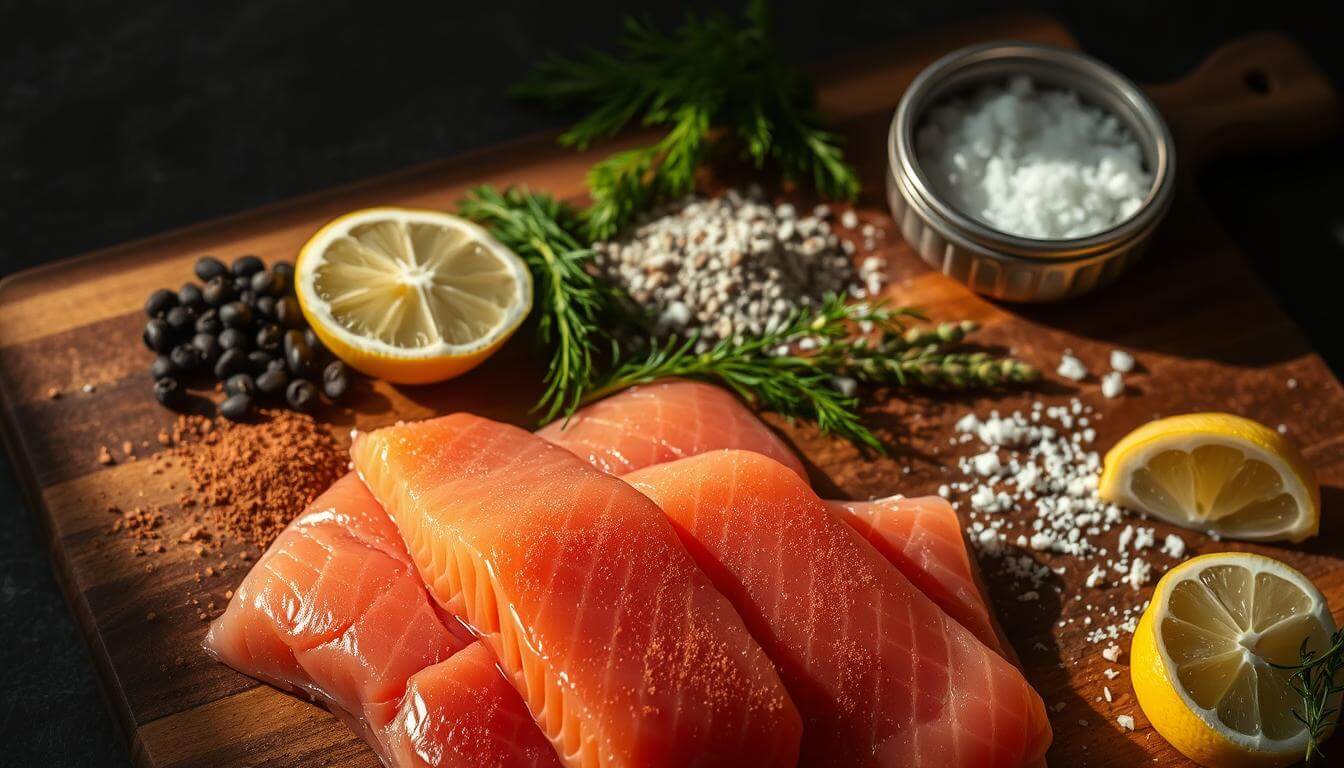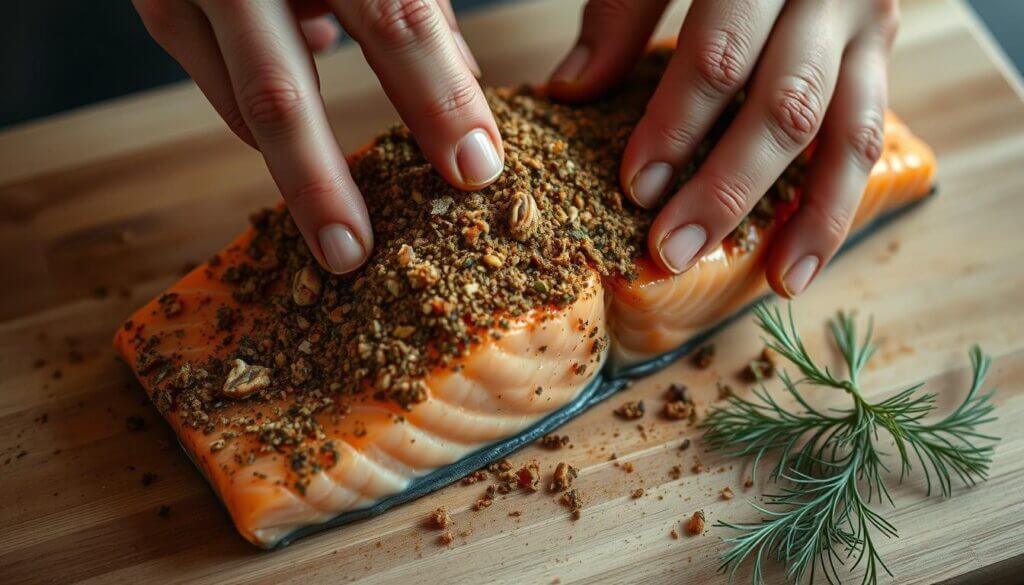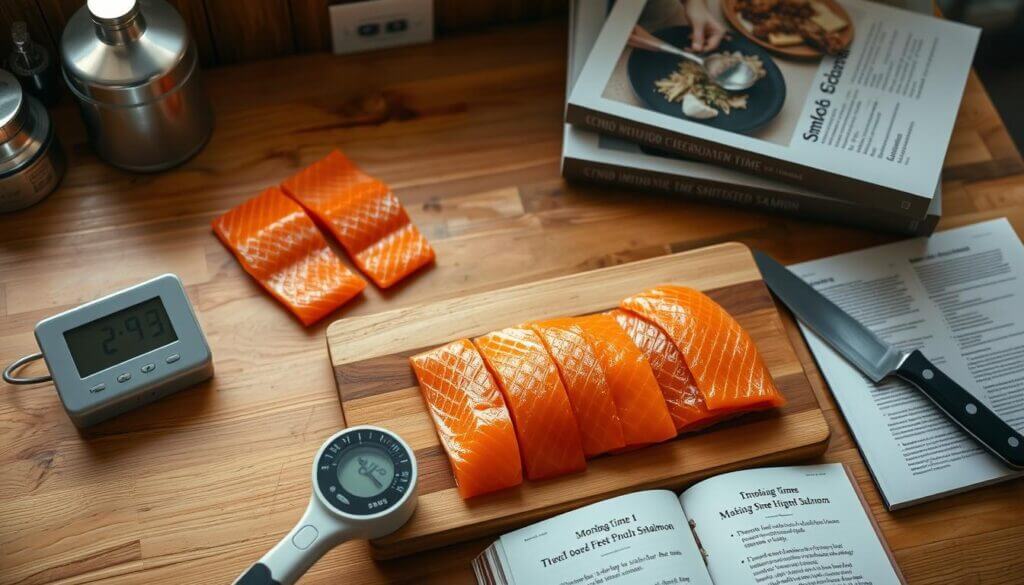Your Guide to Crafting a Delicious Smoked Salmon Rub Recipe

Table of Contents
Imagine biting into smoked salmon that melts on your tongue. Its flavor is bright with dill, subtly sweet, and perfectly seasoned. This is the magic a well-crafted rub creates.
Whether you’re smoking a fillet for a weekend brunch or mastering your first Weber Smokey Mountain Cooker recipe, the right rub makes a big difference. Wendy C. from Portland swears by her smoked salmon rub recipe—saying it turned her from a novice into a family favorite. Susan D. loves substituting brown sugar with maple syrup in her salmon rub recipe sugar for a local farmers’ market crowd.
Creating your own smoked salmon rub isn’t just about spices—it’s about balance. Start with brown sugar, dill weed, salt, and pepper. The dill weed’s gentle tang pairs perfectly with salt’s depth.
Even better? Adjust freely. Double the mix for bold flavor or swap sugars without losing quality.
Key Takeaways
- A basic rub uses brown sugar, dill weed, salt, and black pepper
- Maple syrup works as a sugar substitute in salmon rub recipe sugar
- Dry-brine salmon for 5 hours using a mix of Diamond Crystal kosher salt and brown sugar
- Rub application an hour before smoking ensures even seasoning
- Forming a pellicle after brining improves smoke adhesion
What is a Smoked Salmon Rub?
A smoked salmon rub is a mix of dry ingredients you put on salmon before smoking. It’s made of spices and sweeteners that make the fish taste better. A good salmon rub seasoning recipe has sweet, salty, and smoky flavors for a delicious taste.
Definition of a Smoked Salmon Rub
This mix goes right on the salmon, getting into the meat as it cooks. It’s dry, so it keeps the fish moist. The best dry rub recipe for salmon uses spices that don’t hide the fish’s taste. It seasons and dries the fish, making it taste even better.
Key Ingredients in a Rub
- Brown sugar: Adds sweetness and browns the fish during smoking.
- Coarse salt: Helps even out the seasoning by pulling out moisture.
- Smoked paprika: Gives a smoky base flavor.
- Dill and savory: Adds herbal tastes that go well with fish.
- Garlic and onion powder: Increases savory flavors without being too strong.
You can adjust the amounts to your liking. Adding lime zest can add a nice citrus touch. This mix works well on chicken or veggies too.
Why You Should Use a Rub on Smoked Salmon
Using a spice rub for salmon recipe brings out new flavors and textures. A good salmon seasoning rub recipe creates a protective layer on the salmon. This layer, called a pellicle, keeps juices inside and lets smoke flavors in.
Enhances Flavor
A classic rub has sweet, salty, and smoky flavors. It mixes brown sugar, savory salt, and black pepper. Paprika adds warmth.
You can also add lemon zest or fresh herbs like dill. Seasonings like Old Bay or Cajun give it a unique taste. This mix lets the salmon’s natural flavor shine through.
Adds a Unique Texture
The pellicle forms in about an hour after applying the rub. It creates a crisp crust when smoked. This crust keeps the fish moist and flaky inside.
The sugar in the rub caramelizes, adding sweetness. The contrast between the crust and the salmon’s flaky inside makes each bite special.
Basic Ingredients for Your Smoked Salmon Rub
Creating a tasty smoked salmon rub starts with key ingredients. These elements are the foundation of your mix, ensuring a perfect balance of flavor and texture. Whether you’re making a sweet salmon rub or a spicy one, these basics are crucial.
Common Spices and Herbs
Begin with essential flavors:
- Kosher salt helps the fish absorb moisture, making it tender.
- Brown sugar adds a sweet caramel flavor and a glaze during smoking.
- Cracked black pepper adds a touch of heat without overpowering the salmon.
- Dill brings a fresh, earthy taste, a classic choice for fish.
Optional Add-Ins
Enhance your mix with these extras:
- Garlic powder adds a savory depth without adding moisture.
- Smoked paprika enhances smoky flavors without direct smoke.
- Chili powder adds a gentle kick to your rub.
- Mustard powder boosts umami and helps spices stick to the fish.
Play with the amounts to suit your taste. Keep unused rub in a sealed container for up to six months.
How to Measure Ingredients Accurately
Getting your salmon rub seasoning recipe just right starts with precise measurements. Even tiny mistakes can change the flavor or texture of your dry rub recipe for salmon. Let’s explore how to measure correctly every time.
Measuring exactly ensures your dish tastes the same every time. For instance, using 1 teaspoon of smoked paprika instead of more keeps the smoky flavor balanced. Too much salt can make the fish too salty, while too little makes it taste bland. Measuring right also helps the rub stick to the salmon evenly, so every bite tastes the same.
Tools That Make a Difference
- Digital kitchen scale (measures spices by weight for accuracy)
- Metal measuring spoons (avoid plastic, which can warp over time)
- Mixing bowls with clear volume markings
- Offset spatula to scrape spices into containers
Pro Tips for Every Step
Always level off measuring spoons with a knife when using powders like thyme or paprika. For sticky ingredients like brown sugar, lightly grease spoons with cooking spray. When scaling the recipe, keep the ratios the same: a 3:1 ratio of brown sugar to salt (like 1½ cups brown sugar to ½ cup salt) keeps flavors balanced. Always store extra rub in an airtight container labeled with the date and ingredients.
Pro chefs measure dry ingredients first, then wet components like olive oil. For a 2-pound salmon fillet, use this mix: 4 tsp smoked paprika, 1 tsp each salt, pepper, and thyme, plus 1 tsp each cumin and coriander. Stir well to avoid clumps.
Step-by-Step Guide to Making Smoked Salmon Rub
Learning to make a spice rub for salmon recipe is all about following steps. These steps help you mix and adjust flavors. You’ll get a seasoning mix that brings out the best in your fish.
- Start by mixing 4 parts dark brown sugar with 1 part non-iodized kosher salt in a bowl. Use a whisk to mix until it’s well combined.
- Add ¼ teaspoon each of granulated garlic and onion. Then, stir in black pepper or paprika for more flavor. Make sure to avoid any seasonings with salt to avoid over-salting.
- Put the mix into an airtight container. It will keep for up to 12 months if sealed right.
Before you use it, taste the blend to get the balance right. If it’s too sweet, add a bit of salt. For a smokier taste, add chipotle powder or cumin. Start with small amounts and taste as you go.
- Nutritional facts per tablespoon: 28 calories, 6.8g carbs, 439mg sodium.
- Equipment: Use labeled spice jars for organization.
- Pro tip: Let the rub sit on the salmon for 30 minutes before smoking. It helps the flavors soak in better.
Try different things with this salmon seasoning rub recipe. Add some citrus zest or herbs like dill. Always keep leftovers in a cool, dark spot for later use.
Tips for Applying Your Rub on Salmon

Getting your smoked salmon rub recipe right means every bite is full of flavor. For a salmon rub recipe -sugar, how you apply it is just as important as what’s in it. Here are some tips to help you season evenly and deeply.
Even Distribution Techniques
- Use 1 tablespoon of rub per pound of salmon. Sprinkle it evenly over the flesh, then gently press it into the surface.
- Put more rub on thicker parts like the center, where it takes longer to cook. Use less on thinner areas to avoid too much seasoning.
- After applying, let the salmon rest in the fridge uncovered for 30 minutes. This helps the seasoning stick before smoking.
Recommended Marinade Time
Cure the salmon in the fridge for at least 8 hours—24 hours max—to balance salt and moisture. Here’s how:
- Place the rubbed salmon on a wire rack over a baking sheet. Refrigerate uncovered.
- Rinse the salmon after curing, then pat dry. Let it air-dry uncovered in the fridge for 1–2 hours. This improves smoke absorption.
Pro tip: If short on time, apply the rub 2 hours before smoking. Always store unused rub in an airtight container for future use.
Smoking Your Salmon: Best Practices
Mastering the smoking process makes your salmon rub seasoning recipe stand out. Begin by heating your smoker to 225–275°F. Use a Traeger or bullet-style smoker. This step prevents overcooking and boosts the flavor of your dry rub.
Preparing the Smoker
Here’s how to get the best results:
- Preheat your smoker to the target temperature before adding salmon.
- Apply a dry brine first: pat salmon dry, then coat evenly with your rub. Let it rest 30 minutes in the fridge.
- Place fillets skin-side down on the smoker grate. Avoid overcrowding to ensure even smoke circulation.
Ideal Wood Choices for Smoking
Choose woods that enhance the salmon’s taste:
| Wood Type | Flavor Profile | Best For |
|---|---|---|
| Cherry | Sweet, mild, and fruity | Rich salmon rub seasoning recipes |
| Apple | Subtle sweetness with a clean finish | Bright citrus or herb-infused dry rubs |
| Maple | Warm, nutty undertones | Classic or savory rubs |
Avoid mesquite, as it can overpower the salmon’s taste.
Keep an eye on the internal temperature with a probe. Aim for 130–135°F to avoid dryness. For a dry rub recipe for salmon, use fruit woods like apple or cherry with light seasonings. Adjust the smoking time based on the fillet’s thickness. Let the fish rest 5–10 minutes after smoking to keep the juices in.
Cooking Times and Temperatures for Smoked Salmon
Perfectly smoking salmon with your spice rub for salmon recipe starts with mastering the right cooking parameters. Follow these guidelines to achieve flaky, tender results every time.

Set your smoker to 225–250°F and aim for an internal temperature of 145–155°F in the thickest part of the salmon. Most fillets take 1–2 hours to smoke, with thicker cuts requiring closer monitoring. Always use a meat thermometer to confirm doneness.
- Smoker consistency: Maintain steady heat to avoid overcooking.
- Thickness matters: Thicker fillets need longer smoking time.
- Salmon seasoning rub recipe depth: Heavier rubs may require slight adjustments in timing.
Check temperature frequently during the last 30 minutes. Once done, rest the salmon for 5–10 minutes before serving. Adjust times if using gas grills or electric smokers by monitoring internal temps closely.
Creative Variations of Smoked Salmon Rub
Make your smoked salmon rub recipe even better with these easy tweaks. Try bold spices or zesty twists to change your dish. Here’s how to make your smoked salmon rub your own.
Sweet vs. Savory Flavors
Change the sugar levels to go from sweet to bold. For a smoked salmon rub recipe -sugar, use less brown sugar or none at all. Add some heat with ½ tsp cayenne or sweet paprika for more flavor. Mix in dried oregano or dill for a fresh taste. Keep trying until it tastes just right.
- Reduce sugar: Make it savory by using less or no brown sugar.
- Add spice: Mix in cayenne for heat or smoked paprika for depth.
Adding Zest with Citrus
Citrus brings a bright, tangy flavor. Grate lime or lemon zest into your rub before putting it on salmon. Try these bold pairings:
- Zest from 1 lime with salt and pepper for a zesty crust.
- Pineapple salsa with smoked paprika for a tropical twist.
- Citrus-based sushi rolls: Layer smoked salmon, cucumber, and cream cheese, then roll with rub. Serve with spicy mayo for contrast.
These tweaks turn a basic smoked salmon rub recipe into something special. Store any leftover rub in an airtight container for later.
Serving Suggestions for Smoked Salmon
After smoking your salmon with a salmon rub seasoning recipe or dry rub recipe for salmon, how you serve it matters a lot. These tips will make your meal unforgettable.
Pairing with Side Dishes
- Crisp salads: Try arugula or watercress with lemon zest and Parmesan.
- Roasted vegetables: Pair with beetroot, asparagus, or sweet potatoes.
- Creamy sides: Serve with mashed potatoes or dill-pickled veggies.
- Grain bowls: Top quinoa or farro with avocado and fresh herbs.
Presentation Tips
Make your plate look as good as it tastes:
- Layer smoked salmon slices on slate or cedar planks.
- Garnish with microgreens or edible flowers.
- Drizzle with a light citrus glaze before serving.
| Category | Meal Idea | How to Make It |
|---|---|---|
| Brunch | Smoked Salmon & Avocado Toast | Top toasted sourdough with smashed avocado, salmon, and everything bagel seasoning. |
| Appetizers | Chef’s Platter | Arrange salmon with crème fraîche, salmon roe, and dill on a marble board. |
| Main Dishes | Smoked Salmon Risotto | Stir strips into creamy arborio rice with lemon zest and Parmesan. |
| Snacks | Tacos | Fill corn tortillas with salmon, jalapeños, and cilantro-lime crema. |
Storage and Shelf Life of Your Smoked Salmon Rub
Storing your spice rub for salmon and smoked salmon right is key. It keeps both fresh and safe. Follow these steps to enjoy them at their best.
Best Practices for Storing Rubs
Keep your salmon seasoning rub in an airtight container in a cool, dark place. This stops moisture from ruining the spices, which is important in humid areas. Check the spices’ expiration dates—old ones might not work as well.
If lumps form, shake the container or gently break them with a spoon.
How Long You Can Keep It
Your spice blend will stay good for 6 months if stored right. Smoked salmon can last 2 weeks in the fridge and 2-12 months in the freezer. Hot-smoked salmon is best eaten within 2 weeks, while cold-smoked salmon should be consumed in 1 week or frozen for 1 month.
Always wrap salmon tightly to keep it fresh. If salmon smells sour, has slime, or looks different, throw it away. Thawed frozen salmon should be eaten in 3-4 days. Vacuum-sealed salmon can last up to 3 weeks in the fridge.
Remember, improper storage can lead to bacteria like listeria. Storing it right keeps your hard work safe and healthy.
